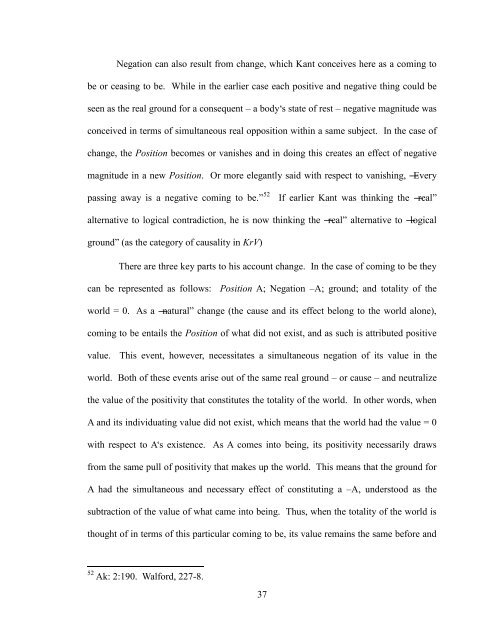The Doctrine of Self-positing and Receptivity in Kant's Late ...
The Doctrine of Self-positing and Receptivity in Kant's Late ...
The Doctrine of Self-positing and Receptivity in Kant's Late ...
You also want an ePaper? Increase the reach of your titles
YUMPU automatically turns print PDFs into web optimized ePapers that Google loves.
Negation can also result from change, which Kant conceives here as a com<strong>in</strong>g to<br />
be or ceas<strong>in</strong>g to be. While <strong>in</strong> the earlier case each positive <strong>and</strong> negative th<strong>in</strong>g could be<br />
seen as the real ground for a consequent – a body‘s state <strong>of</strong> rest – negative magnitude was<br />
conceived <strong>in</strong> terms <strong>of</strong> simultaneous real opposition with<strong>in</strong> a same subject. In the case <strong>of</strong><br />
change, the Position becomes or vanishes <strong>and</strong> <strong>in</strong> do<strong>in</strong>g this creates an effect <strong>of</strong> negative<br />
magnitude <strong>in</strong> a new Position. Or more elegantly said with respect to vanish<strong>in</strong>g, ―Every<br />
pass<strong>in</strong>g away is a negative com<strong>in</strong>g to be.‖ 52 If earlier Kant was th<strong>in</strong>k<strong>in</strong>g the ―real‖<br />
alternative to logical contradiction, he is now th<strong>in</strong>k<strong>in</strong>g the ―real‖ alternative to ―logical<br />
ground‖ (as the category <strong>of</strong> causality <strong>in</strong> KrV)<br />
<strong>The</strong>re are three key parts to his account change. In the case <strong>of</strong> com<strong>in</strong>g to be they<br />
can be represented as follows: Position A; Negation –A; ground; <strong>and</strong> totality <strong>of</strong> the<br />
world = 0. As a ―natural‖ change (the cause <strong>and</strong> its effect belong to the world alone),<br />
com<strong>in</strong>g to be entails the Position <strong>of</strong> what did not exist, <strong>and</strong> as such is attributed positive<br />
value. This event, however, necessitates a simultaneous negation <strong>of</strong> its value <strong>in</strong> the<br />
world. Both <strong>of</strong> these events arise out <strong>of</strong> the same real ground – or cause – <strong>and</strong> neutralize<br />
the value <strong>of</strong> the positivity that constitutes the totality <strong>of</strong> the world. In other words, when<br />
A <strong>and</strong> its <strong>in</strong>dividuat<strong>in</strong>g value did not exist, which means that the world had the value = 0<br />
with respect to A‘s existence. As A comes <strong>in</strong>to be<strong>in</strong>g, its positivity necessarily draws<br />
from the same pull <strong>of</strong> positivity that makes up the world. This means that the ground for<br />
A had the simultaneous <strong>and</strong> necessary effect <strong>of</strong> constitut<strong>in</strong>g a –A, understood as the<br />
subtraction <strong>of</strong> the value <strong>of</strong> what came <strong>in</strong>to be<strong>in</strong>g. Thus, when the totality <strong>of</strong> the world is<br />
thought <strong>of</strong> <strong>in</strong> terms <strong>of</strong> this particular com<strong>in</strong>g to be, its value rema<strong>in</strong>s the same before <strong>and</strong><br />
52 Ak: 2:190. Walford, 227-8.<br />
37


